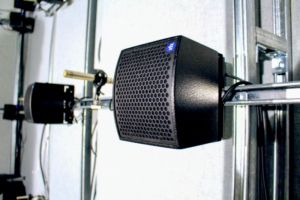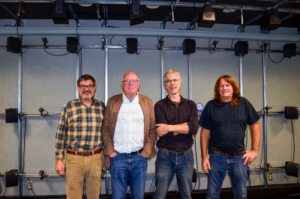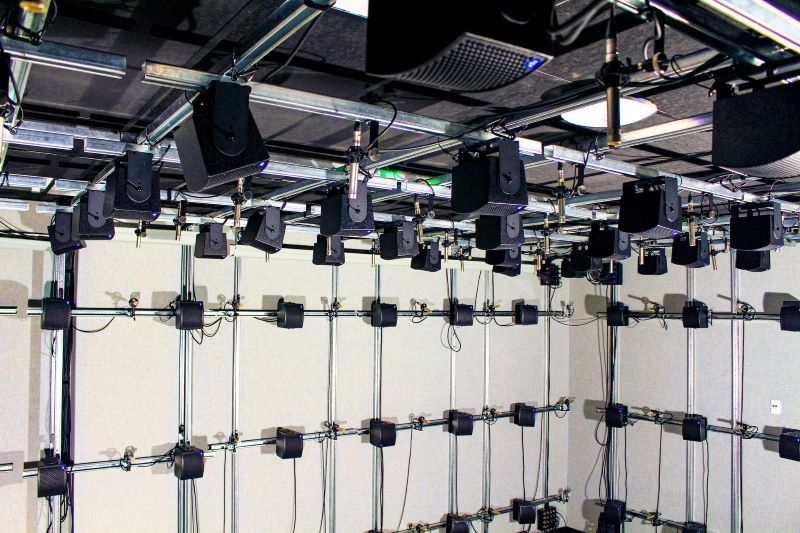Simon Fraser University (SFU) is consistently ranked among Canada’s top research institutions. Unsurprisingly, then, it has taken a pioneering step into immersive communication and spatial acoustics processing. Due to a recent grant, SFU established an acoustics lab equipped with 128 Renkus-Heinz C Series loudspeakers to support its innovative research in the field of immersive communication.
Located across British Columbia’s three largest cities — Burnaby, Surrey and Vancouver — SFU offers diverse programs. Indeed, they range from anthropology to marine science. The university’s drive to leverage technology for societal benefit led to the creation of a new lab focused on 3D multimedia applications, including surround sound, video and spatial acoustics. Commonly, this is referred to as “immersive communication.”
Renkus-Heinz Helps Bring Immersive Communication Vision to Life
Senior professor Rodney Vaughan spearheaded the project. Working in partnership with TiMax, Advanced Audio, DirectOut, Innosonix Technologies and Renkus-Heinz, the collaborators bring his vision to life. “Rodney came to me over 10 years ago with a bold idea for an acoustic lab where we could push the boundaries of sound research,” Tim Bartoo, TiMax senior developer, recalls. “He talked about creating spaces where, for instance, you could have a bedroom on a noisy street that feels as quiet as the countryside.”
The project, of course, took several years to secure funding. However, the grant ultimately came through. Then, Vaughan and Bartoo began assembling a team to execute the ambitious vision. “Rodney is known for his expertise in radar and advanced antenna design,” Bartoo notes. “And he was confident that the equations for sound, though a different medium, would work similarly to those used in his previous research.”
Well, the lab is now a reality. It’s centered on two TiMax spatial processors, which were selected for their exceptional spatial functionality and flexibility. This technology is vital for the range of experiments planned in the lab. These include simulating complex sound fields and testing noise-canceling concepts. In addition to the 128 Renkus-Heinz CX41 speakers, 128 Advanced Audio microphones were installed. All are integrated via a Dante network to allow seamless communication between components.
Fred Gilpin was brought in early to help design the physical setup of the lab. Gilpin is, of course, a prominent acoustic consultant. “Fred handled the precision of the speaker placement,” Bartoo explains. “We have about five miles of custom cabling in that room. His attention to detail was critical because every microphone and speaker needed to be precisely located to ensure accurate sound replication.”
Renkus-Heinz CX41 Four-Inch Coaxial Two-Way Loudspeakers
The Renkus-Heinz CX41 four-inch coaxial two-way loudspeakers were a great choice for the lab. Indeed, their compact size and sonic performance made them ideal. Featuring extended-range soft-dome tweeters, these speakers deliver smooth, low-distortion sound capable of reaching frequencies beyond 20kHz. “I had worked with Renkus-Heinz before, and I knew the CX41s would be perfect for this project,” Gilpin says. “Phase response was crucial, as much of the sound being tested is off-axis, and the CX41’s natural, transparent sound made it a great fit.”

Nearly 130 Renkus-Heinz CX41 loudspeakers were chosen for the project. Image courtesy of Renkus-Heinz.
Renkus-Heinz’s Complex Conic Horn technology likewise played a pivotal role in ensuring consistent coverage throughout the lab. This advanced design provides constant beam width over a wide frequency range. Thus, it eliminates typical horn-related issues like polar pattern distortion. “With Complex Conic Horns, we could ensure the lab had uniform sound coverage, whether on- or off-axis,” Gilpin adds.
As the lab neared completion, the team was eager to put the space to use. “One of the most exciting projects we’re working toward is creating a sound-canceled room,” Vaughan explains. He continues, “Imagine a corner of the room where two people can have a conversation, and no one outside that space can hear it — thanks to acoustic isolation. Or a space where you hear nothing, even in a noisy environment. This kind of innovation hasn’t been done before.”
Another area of interest for the lab is enhancing room acoustics, particularly in overly reflective environments. By using advanced modeling and soundfield control, researchers hope to develop systems that analyze a room’s acoustics and compensate for excessive reverberation. Thus, they would improve intelligibility and sound quality in very challenging spaces.
Beyond Research Projects and Immersive Communication
Beyond these research projects, Bartoo is particularly excited about testing TiMax’s new reverberation subsystem in the lab. “We’ve incorporated four reverb engines that can create dynamic, localized reverberation in different parts of the room,” he explains. “With the lab’s configuration, we can simulate anything from a cavernous cathedral to a tight, controlled acoustic space. It’s going to be fascinating to see how well these reverberation patterns replicate reality in such a controlled environment.”

The team behind the lab want to dive deeper into immersive communication. Image courtesy of Renkus-Heinz.
Already, the lab has drawn significant interest from the academic and research communities. Indeed, there are numerous proposed projects on the horizon. “We recently completed our first 128-channel recording,” Bartoo shares. “We walked around the room, talking and clapping. And, when we played it back, you could pinpoint exactly where the sounds were coming from. When you closed your eyes, you could visualize who was where in the room. It’s pretty neat.”
As the lab continues to evolve, the potential for immersive communication research at SFU is, of course, immense. With a focus on understanding and manipulating sound fields, and with the help of technology from Renkus-Heinz, this facility is poised to make significant contributions to the future of acoustic technology and its real-world applications.




